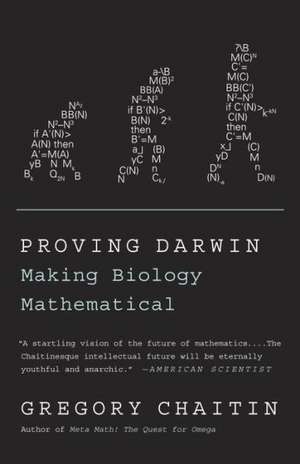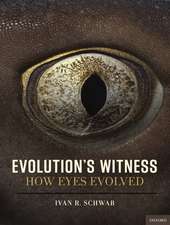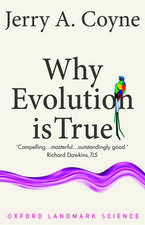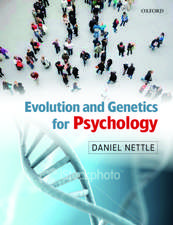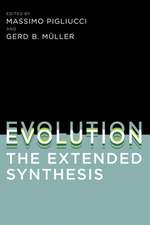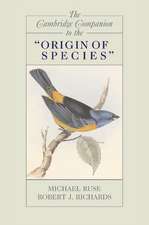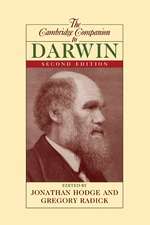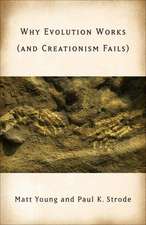Proving Darwin: Making Biology Mathematical
Autor Gregory Chaitinen Limba Engleză Paperback – 25 feb 2013
For years it has been received wisdom among most scientists that, just as Darwin claimed, all of the Earth’s life-forms evolved by blind chance. But does Darwin’s theory function on a purely mathematical level? Has there been enough time for evolution to produce the remarkable biological diversity we see around us? It’s a question no one has yet answered—in fact, no one has attempted to answer it until now. In this illuminating and provocative book, Gregory Chaitin elucidates the mathematical scheme he’s developed that can explain life itself, and examines the works of mathematical pioneers John von Neumann and Alan Turing through the lens of biology. Fascinating and thought-provoking, Proving Darwin makes clear how biology may have found its greatest ally in mathematics.
Preț: 102.95 lei
Nou
Puncte Express: 154
Preț estimativ în valută:
19.70€ • 20.49$ • 16.27£
19.70€ • 20.49$ • 16.27£
Carte disponibilă
Livrare economică 25 martie-08 aprilie
Preluare comenzi: 021 569.72.76
Specificații
ISBN-13: 9781400077984
ISBN-10: 1400077982
Pagini: 123
Ilustrații: ILLUSTRATIONS THROUGHOUT
Dimensiuni: 132 x 203 x 12 mm
Greutate: 0.15 kg
Editura: VINTAGE BOOKS
ISBN-10: 1400077982
Pagini: 123
Ilustrații: ILLUSTRATIONS THROUGHOUT
Dimensiuni: 132 x 203 x 12 mm
Greutate: 0.15 kg
Editura: VINTAGE BOOKS
Notă biografică
Gregory Chaitin is widely known for his work on metamathematics and for his discovery of the celebrated Omega number, which proved the fundamental unknowability of math. He is the author of many books on mathematics, including Meta Math! The Quest for Omega. This is his first book on biology. Chaitin was for many years at the IBM Watson Research Center in New York. The research described in this book was carried out at the Federal University of Rio de Janeiro in Brazil, where Chaitin is now a professor. An Argentine-American, he is an honorary professor at the University of Buenos Aires and has an honorary doctorate from the National University of Cordoba, the oldest university in Argentina.
Extras
One
Introduction: Overview of Proving Darwin
Like many pure mathematicians, I like giving “chalk” talks: improvised talks given on a blackboard or white- board using a minimum of technological assistance. Another strategy is for me to fill the board with what I want to cover just before I start to lecture, while people are still coming in, so that they can take in all the key ideas at a glance. In a large auditorium, however, a projector is necessary, or nobody will see anything.
On the facing page you can see me giving an overview of this book in a large auditorium at the Federal University of Rio Grande do Sul in southern Brazil. The four slides I prepared are on pages 5 and 6. They summarize Chapters 2 to 4, which outline my strategy for making biology mathematical. After you finish reading these chapters, you should review the slides. Then they will make more sense.
You’ve heard people refer to DNA as a computer program? Well, that’s the whole idea: to make this metaphor into a mathematical theory of evolution. In fact, it turns out that the mathematical tools for doing this were already available in the 1970s. More precisely, we will treat evolution as a random walk in software space. Random walks are an idea that mathematicians feel comfortable with, although the space we are walking around in at random is bigger than usual.
I call this proposed new field “metabiology” because it is a highly simplified version of real biology—otherwise I wouldn’t be able to prove any theorems. These theorems are presented in Chapter 5, which is the climax of the book, and was a talk that I gave at the Santa Fe Institute. Chapters 6 to 8 discuss the broader significance of metabiology, theological, political and epistemological. And then there are two appendices.
In the first appendix you can read the crucial section on self-reproducing automata in John von Neumann’s far-seeing “DNA = Software” paper that influenced Sydney Brenner, who in turn influenced Francis Crick—a remarkable fact that I only discovered while working on this book. And the second appendix gives some additional mathematical details that may be of interest to experts.
Finally, I give a short list of suggested further reading, some books and a few articles that are important if you want to really understand metabiology. These are the books and articles that helped me the most to come up with a strategy for making biology mathematical, plus a few more related items that I threw in just for the fun of it. Enjoy them all!
Introduction: Overview of Proving Darwin
Like many pure mathematicians, I like giving “chalk” talks: improvised talks given on a blackboard or white- board using a minimum of technological assistance. Another strategy is for me to fill the board with what I want to cover just before I start to lecture, while people are still coming in, so that they can take in all the key ideas at a glance. In a large auditorium, however, a projector is necessary, or nobody will see anything.
On the facing page you can see me giving an overview of this book in a large auditorium at the Federal University of Rio Grande do Sul in southern Brazil. The four slides I prepared are on pages 5 and 6. They summarize Chapters 2 to 4, which outline my strategy for making biology mathematical. After you finish reading these chapters, you should review the slides. Then they will make more sense.
You’ve heard people refer to DNA as a computer program? Well, that’s the whole idea: to make this metaphor into a mathematical theory of evolution. In fact, it turns out that the mathematical tools for doing this were already available in the 1970s. More precisely, we will treat evolution as a random walk in software space. Random walks are an idea that mathematicians feel comfortable with, although the space we are walking around in at random is bigger than usual.
I call this proposed new field “metabiology” because it is a highly simplified version of real biology—otherwise I wouldn’t be able to prove any theorems. These theorems are presented in Chapter 5, which is the climax of the book, and was a talk that I gave at the Santa Fe Institute. Chapters 6 to 8 discuss the broader significance of metabiology, theological, political and epistemological. And then there are two appendices.
In the first appendix you can read the crucial section on self-reproducing automata in John von Neumann’s far-seeing “DNA = Software” paper that influenced Sydney Brenner, who in turn influenced Francis Crick—a remarkable fact that I only discovered while working on this book. And the second appendix gives some additional mathematical details that may be of interest to experts.
Finally, I give a short list of suggested further reading, some books and a few articles that are important if you want to really understand metabiology. These are the books and articles that helped me the most to come up with a strategy for making biology mathematical, plus a few more related items that I threw in just for the fun of it. Enjoy them all!
Recenzii
“One of the great ideas men of mathematics and computer science.” —New Scientist
“Strange and marvelous. . . Disarmingly funny, but also thrillingly clear.” —The Guardian
“[Chaitin’s] enjoyment of the topics of his own research is infectious.” —The Times Higher Education Supplement
“Call him Omega Man. . . . In the rarefied world of pure mathematics, Gregory Chaitin is indeed something of a venerated superhero.” —Waterloo Region Record
“[Chaitin is] enthusiastic and extremely readable. . . . Amazing. No wonder [he] chose mathematics over physics.” —New Scientist
“The musings of a great mind on a subject beyond most of us.” —Ottawa Citizen
“Provocative. . . . Stimulating. . . . Credit the author for a lively style, lots of useful historical references and an appendix that includes von Neumann’s prescient essay on self-reproducing automata.” —Kirkus Reviews
"Gregory Chaitin has devoted his life to the study of mathematics. . . . A great mind.” —The Victoria Times Colonist
“[Chaitin] is a creative genius.” —Tucson Citizen
“Strange and marvelous. . . Disarmingly funny, but also thrillingly clear.” —The Guardian
“[Chaitin’s] enjoyment of the topics of his own research is infectious.” —The Times Higher Education Supplement
“Call him Omega Man. . . . In the rarefied world of pure mathematics, Gregory Chaitin is indeed something of a venerated superhero.” —Waterloo Region Record
“[Chaitin is] enthusiastic and extremely readable. . . . Amazing. No wonder [he] chose mathematics over physics.” —New Scientist
“The musings of a great mind on a subject beyond most of us.” —Ottawa Citizen
“Provocative. . . . Stimulating. . . . Credit the author for a lively style, lots of useful historical references and an appendix that includes von Neumann’s prescient essay on self-reproducing automata.” —Kirkus Reviews
"Gregory Chaitin has devoted his life to the study of mathematics. . . . A great mind.” —The Victoria Times Colonist
“[Chaitin] is a creative genius.” —Tucson Citizen
